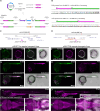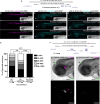pIGLET: Safe harbor landing sites for reproducible and efficient transgenesis in zebrafish
- PMID: 38838146
- PMCID: PMC11152119
- DOI: 10.1126/sciadv.adn6603
pIGLET: Safe harbor landing sites for reproducible and efficient transgenesis in zebrafish
Abstract
Standard zebrafish transgenesis involves random transgene integration with resource-intensive screening. While phiC31 integrase-based attP/attB recombination has streamlined transgenesis in mice and Drosophila, validated attP-based landing sites for universal applications are lacking in zebrafish. Here, we developed phiC31 Integrase Genomic Loci Engineered for Transgenesis (pIGLET) as transgenesis approach, with two attP landing sites pIGLET14a and pIGLET24b from well-validated Tol2 transgenes. Both sites facilitate diverse transgenesis applications including reporters and Cre/loxP transgenes. The pIGLET14a and pIGLET24b landing sites consistently yield 25 to 50% germline transmission, substantially reducing the resources needed for transgenic line generation. Transgenesis into these sites enables reproducible expression patterns in F0 zebrafish embryos for enhancer discovery and testing of gene regulatory variants. Together, our new landing sites streamline targeted, reproducible zebrafish transgenesis as a robust platform for various applications while minimizing the workload for generating transgenic lines.
Figures




Update of
-
pIGLET: Safe harbor landing sites for reproducible and efficient transgenesis in zebrafish.bioRxiv [Preprint]. 2023 Dec 12:2023.12.08.570868. doi: 10.1101/2023.12.08.570868. bioRxiv. 2023. Update in: Sci Adv. 2024 Jun 7;10(23):eadn6603. doi: 10.1126/sciadv.adn6603. PMID: 38106217 Free PMC article. Updated. Preprint.
Similar articles
-
pIGLET: Safe harbor landing sites for reproducible and efficient transgenesis in zebrafish.bioRxiv [Preprint]. 2023 Dec 12:2023.12.08.570868. doi: 10.1101/2023.12.08.570868. bioRxiv. 2023. Update in: Sci Adv. 2024 Jun 7;10(23):eadn6603. doi: 10.1126/sciadv.adn6603. PMID: 38106217 Free PMC article. Updated. Preprint.
-
Site-directed zebrafish transgenesis into single landing sites with the phiC31 integrase system.Dev Dyn. 2013 Aug;242(8):949-963. doi: 10.1002/dvdy.23989. Epub 2013 Jul 3. Dev Dyn. 2013. PMID: 23723152 Free PMC article.
-
Instantaneous visual genotyping and facile site-specific transgenesis via CRISPR-Cas9 and phiC31 integrase.Biol Open. 2024 Sep 15;13(9):bio061666. doi: 10.1242/bio.061666. Epub 2024 Sep 3. Biol Open. 2024. PMID: 39225039 Free PMC article.
-
Measures implemented in the school setting to contain the COVID-19 pandemic.Cochrane Database Syst Rev. 2022 Jan 17;1(1):CD015029. doi: 10.1002/14651858.CD015029. Cochrane Database Syst Rev. 2022. Update in: Cochrane Database Syst Rev. 2024 May 2;5:CD015029. doi: 10.1002/14651858.CD015029.pub2. PMID: 35037252 Free PMC article. Updated.
-
Antidepressants for pain management in adults with chronic pain: a network meta-analysis.Health Technol Assess. 2024 Oct;28(62):1-155. doi: 10.3310/MKRT2948. Health Technol Assess. 2024. PMID: 39367772 Free PMC article.
Cited by
-
Single-cell transcriptional dynamics in a living vertebrate.bioRxiv [Preprint]. 2025 Jun 11:2024.01.03.574108. doi: 10.1101/2024.01.03.574108. bioRxiv. 2025. PMID: 38260569 Free PMC article. Preprint.
-
A recombinase-activated ribozyme to knock down endogenous gene expression in zebrafish.PLoS Genet. 2025 Feb 7;21(2):e1011594. doi: 10.1371/journal.pgen.1011594. eCollection 2025 Feb. PLoS Genet. 2025. PMID: 39919116 Free PMC article.
-
Pythia: Non-random DNA repair allows predictable CRISPR/Cas9 integration and gene editing.bioRxiv [Preprint]. 2024 Sep 23:2024.09.23.614424. doi: 10.1101/2024.09.23.614424. bioRxiv. 2024. PMID: 39386429 Free PMC article. Preprint.
-
TransTag enables simple and efficient transgene mapping in zebrafish via tagmentation.Cell Rep Methods. 2025 Jul 21;5(7):101090. doi: 10.1016/j.crmeth.2025.101090. Epub 2025 Jul 8. Cell Rep Methods. 2025. PMID: 40633543 Free PMC article.
-
Genetic context of transgene insertion can influence neurodevelopment in zebrafish.bioRxiv [Preprint]. 2025 Mar 5:2025.02.28.640904. doi: 10.1101/2025.02.28.640904. bioRxiv. 2025. PMID: 40093151 Free PMC article. Preprint.
References
-
- Felker A., Mosimann C., Contemporary zebrafish transgenesis with Tol2 and application for Cre/lox recombination experiments. Methods Cell Biol. 135, 219–244 (2016). - PubMed
-
- Kwan K. M., Fujimoto E., Grabher C., Mangum B. D., Hardy M. E., Campbell D. S., Parant J. M., Yost H. J., Kanki J. P., Bin Chien C., The Tol2kit: A multisite gateway-based construction kit for Tol2 transposon transgenesis constructs. Dev. Dyn. 236, 3088–3099 (2007). - PubMed
-
- Kikuta H., Kawakami K., Transient and stable transgenesis using tol2 transposon vectors. Methods Mol. Biol. 546, 69–84 (2009). - PubMed
-
- Carney T. J., Mosimann C., Switch and trace: Recombinase genetics in zebrafish. Trends Genet. 34, 362–378 (2018). - PubMed
MeSH terms
Substances
Grants and funding
LinkOut - more resources
Full Text Sources
Research Materials

